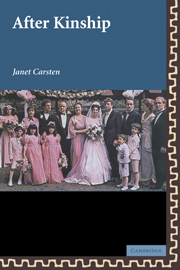Book contents
- Frontmatter
- Contents
- Acknowledgments
- 1 Introduction: After Kinship?
- 2 Houses of Memory and Kinship
- 3 Gender, Bodies, and Kinship
- 4 The Person
- 5 Uses and Abuses of Substance
- 6 Families into Nation : The Power of Metaphor and the Transformation of Kinship
- 7 Assisted Reproduction
- 8 Conclusion
- Bibliography
- Index
5 - Uses and Abuses of Substance
Published online by Cambridge University Press: 05 June 2012
- Frontmatter
- Contents
- Acknowledgments
- 1 Introduction: After Kinship?
- 2 Houses of Memory and Kinship
- 3 Gender, Bodies, and Kinship
- 4 The Person
- 5 Uses and Abuses of Substance
- 6 Families into Nation : The Power of Metaphor and the Transformation of Kinship
- 7 Assisted Reproduction
- 8 Conclusion
- Bibliography
- Index
Summary
In the shift from kinship to relatedness, we have seen how a focus on the person, gender, and house provided ways to open up kinship to new kinds of analysis. One other key term, used by anthropologists to dismantle kinship in its more classic guises, has been substance. In this enterprise, David Schneider's work was highly influential. Substance was one of Schneider's key terms, which he used to unlock the cultural meanings of American Kinship (1980). Anthropologists working in India and Papua New Guinea, among other places, have adopted substance as a way of understanding kinship in more processual terms, looking at how persons were constituted through their relations with others.
Substance was a kind of catch-all term that can be used to trace the bodily transformation of food into blood, sexual fluids, sweat, and saliva, and to analyze how these passed from person to person through eating together, living in houses, having sexual relations, and performing ritual exchanges. It thus necessarily links together some of the topics I have covered in previous chapters – the house and feeding, personhood and relations, bodies, and gender. In this chapter, I explore exactly how and why anthropologists have used the term substance, and where this focus has taken the study of kinship. I begin with some brief examples before putting substance into its anthropological context.
- Type
- Chapter
- Information
- After Kinship , pp. 109 - 135Publisher: Cambridge University PressPrint publication year: 2003



